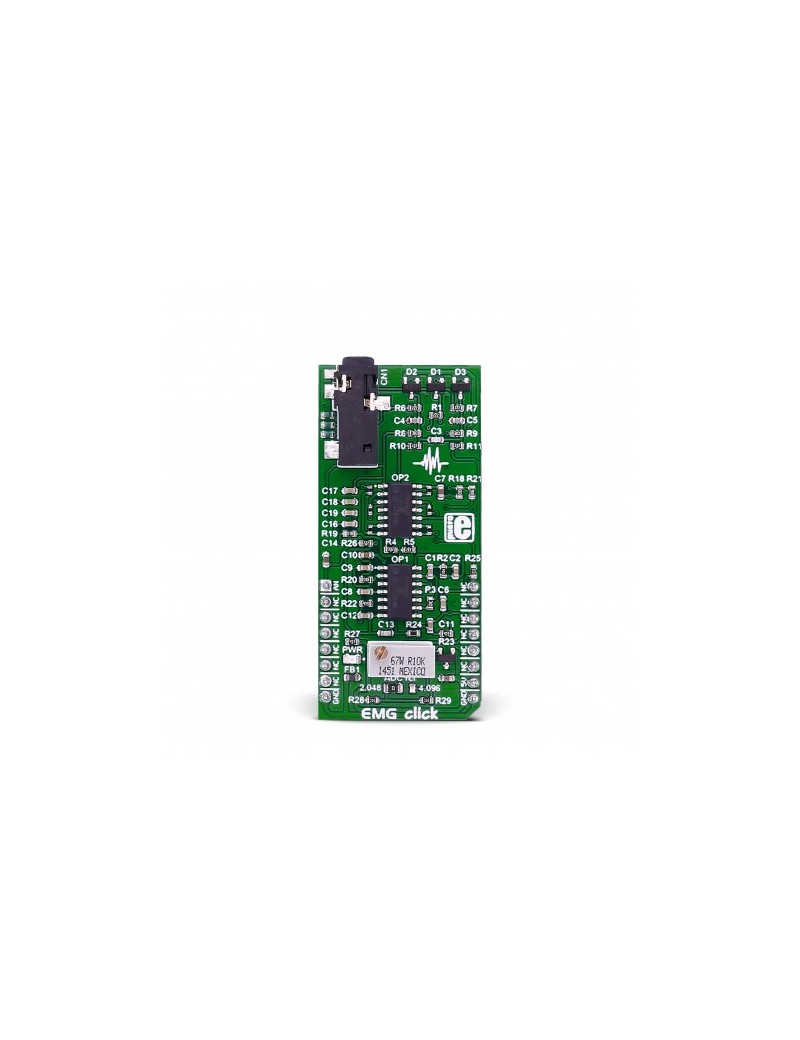

No products in the cart.


EMG Click is a compact add-on board that checks the condition of nerves and muscles. This board features two MCP609s, micropower CMOS operational amplifiers from Microchip. The EMG Click is an EMG machine on a Click board™ and requires little setup. The final measurement results can be displayed as a graphical presentation using MikroPlot, a free Windows data visualization tool. The minimal setup requires cable and disposable adhesive pads, which MIKROE offers. Of course, you will also need a target board with an MCU with at least a 10-bit ADC (preferably powered by an external battery). The sampling rate should be at least 256Hz. This Click board™ makes the perfect solution for developing applications for measuring the electrical activity produced by skeletal muscles.
EMG Click is supported by a mikroSDK compliant library, which includes functions that simplify software development. This Click board™ comes as a fully tested product, ready to be used on a system equipped with the mikroBUS™ socket.
EMG Click is based on two MCP609s, micropower CMOS operational amplifiers from Microchip. These are unity-gain stable Op Amps with a low offset voltage, including rail-to-rail output swing capability and a low input bias current. The MAX6106, a low-cost micropower, low-dropout, high-output-current voltage reference from Analog Devices, provides the reference voltage. You can choose a reference voltage between 2.048 and 4.96V over the ADC REF jumper, where the lower is set by default. When you connect all three electrodes to each other, the output should be constant voltage. There is also a trimmer potentiometer that adjusts the gain. The jumper and trimmer potentiometer are used to make the output voltage level from EMG Click accommodate the input voltage level of ADC, which will be used.
Electromyography, or EMG, is a diagnostic technique for measuring the electrical activity of muscles. It is often used to diagnose the health of these muscles and the neurons that control them. These neurons are called motor neurons. They transmit electrical signals, and the muscles contract when this happens. An EMG Click collects these signals and translates them into a graphical representation. The electrodes are connected to the board with a cable that plugs into the onboard 3.5mm phone jack. For optimal results, place the first DRL electrode on the wrist of the hand. Place the second and third electrodes on the muscle you want to measure.
EKG Click provides ESD protection, overvoltage protection, and overcurrent protection, where the input block acts as a filter that prevents radio waves from entering the preamplifier. After it passes the preamplifier, high-pass filter, and amplifier, the signal goes again through the high-pass filter and then the low-pass filter until it can be read from the host MCU over an analog AN pinmikroBUS™ socket.
EMG Click also consists of the DRL circuit (driven right leg), an electronic circuit often added to biological signal amplifiers to reduce common-mode interference. Biological signal amplifiers such as EMG circuits measure very small electrical signals emitted by the body, often as small as several microvolts. As the patient’s body acts as an antenna, the DRL eliminates interference noise by actively canceling it.
This Click board™ can be operated only with a 5V logic voltage level. The board must perform appropriate logic voltage level conversion before using MCUs with different logic levels. However, the Click board™ comes equipped with a library containing functions and an example code that can be used as a reference for further development.
| Type | Biometrics |
| Applications | Can be used for developing applications for measuring the electrical activity produced by skeletal muscles |
| On-board modules | MCP609 - micropower CMOS operational amplifiers from Microchip. |
| Key Features | ESD protection, overvoltage protection, overcurrent protection, high and low filters, preamplifier, and amplifier signal, DRL circuit, voltage reference selection, adjustable gain, MikroPlot visualization tool for graphic presentation, and more |
| Interface | Analog |
| Feature | No ClickID |
| Compatibility | mikroBUS™ |
| Click board size | L (57.15 x 25.4 mm) |
| Input Voltage | 5V |
This table shows how the pinout on EMG Click corresponds to the pinout on the mikroBUS™ socket (the latter shown in the two middle columns).
| Label | Name | Default | Description |
|---|---|---|---|
| - | PWR | - | Power LED Indicator |
| JP1 | ADC REF | Left | Reference Voltage Selection 2.048/4.096: Left position 2.048, Right position 4.096 |
| VR1 | - | - | Gain Adjustment Trimmer Potentiometer |
| Description | Min | Typ | Max | Unit |
|---|---|---|---|---|
| Supply Voltage | - | 5 | - | V |
| EMG Waveform | 0 | - | 4.096 | V |
We provide a library for the EMG Click as well as a demo application (example), developed using MIKROE compilers. The demo can run on all the main MIKROE development boards.
Package can be downloaded/installed directly from NECTO Studio Package Manager(recommended), downloaded from our LibStock™ or found on Mikroe github account.
Library Description
This library contains API for EMG Click driver.
Key functions
emg_read_an_pin_value EMG read AN pin value function.
emg_read_an_pin_voltage EMG read AN pin voltage level function.